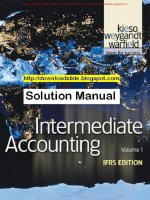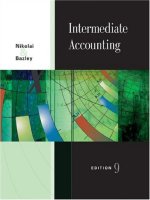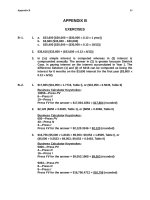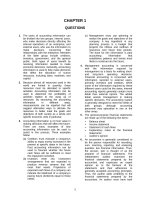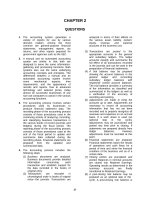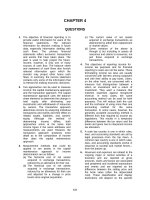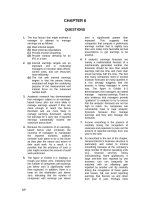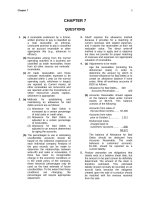Solution manual intermediate accounting 7th by nelson spiceland ch04
Bạn đang xem bản rút gọn của tài liệu. Xem và tải ngay bản đầy đủ của tài liệu tại đây (645.42 KB, 66 trang )
Find more slides, ebooks, solution manual and testbank on www.downloadslide.com
Chapter 4
The Income Statement and Statement of Cash Flows
QUESTIONS FOR REVIEW OF KEY TOPICS
Question 4-1
The income statement is a change statement that reports transactions — revenues, expenses,
gains and losses — that cause owners’ equity to change during a specified reporting period.
Question 4-2
Comprehensive income is the total change in equity for a reporting period other than from
transactions with owners. Reporting comprehensive income can be accomplished with a separate
statement or by including the information in either the income statement or the statement of changes
in shareholders’ equity.
Question 4-3
Income from continuing operations includes the revenue, expense, gain and loss transactions
that will probably continue in future periods. It is important to segregate the income effects of these
items because they are the most important transactions in terms of predicting future cash flows.
Question 4-4
Operating income includes revenues and expenses that are directly related to the principal
revenue generating activities of the company. Nonoperating income includes items that are not
directly related to these activities.
Question 4-5
The single-step format first lists all revenues and gains included in income from continuing
operations to arrive at total revenues and gains. All expenses and losses are then grouped and
subtotaled, subtracted from revenues and gains to arrive at income from continuing operations. The
multiple-step format reports a series (multiple) of intermediate totals such as gross profit, operating
income, and income before taxes. Very often income statements adopt variations of these formats,
falling somewhere in between the two extremes.
Question 4-6
The term earnings quality refers to the ability of reported earnings (income) to predict a
company’s future earnings. After all, an income statement simply reports on events that already have
occurred. The relevance of any historical-based financial statement hinges on its predictive value.
Question 4-7
Restructuring costs include costs associated with shutdown or relocation of facilities or
downsizing of operations. They are reported as an operating expense in the income statement.
Solutions Manual, Vol.1, Chapter 4
© The McGraw-Hill Companies, Inc., 2007
4-1
Find more slides, ebooks, solution manual and testbank on www.downloadslide.com
Answers to Questions (continued)
Question 4-8
The process of intraperiod tax allocation matches tax expense or tax benefit with each major
component of income, specifically continuing operations and any item reported below continuing
operations. The process is necessary to achieve the desired result of separating the total income
effects of continuing operations from the two separately reported items - discontinued operations and
extraordinary items, and also to show the after-tax effect of each of those two components.
Question 4-9
A component of an entity comprises operations and cash flows that can be clearly
distinguished, operationally and for financial reporting purposes.
The net-of-tax income effects of a discontinued operation must be disclosed separately in the
income statement, below income from continuing operations. The income effects include income
(loss) from operations and gain (loss) on disposal. The gain or loss on disposal must be disclosed
either on the face of the statement or in a disclosure note. If the component is held for sale but not
sold by the end of the reporting period, the income effects will include income (loss) from operations
and an impairment loss if the fair value less costs to sell is less than the book value of the
component’s assets. The income (loss) from operations of the component is reported separately in
discontinued operations on prior income statements presented for comparative purposes.
Question 4-10
Extraordinary items are material gains and losses that are both unusual in nature and infrequent
in occurrence, taking into account the environment in which the entity operates.
Question 4-11
Extraordinary gains and losses are presented, net of tax, in the income statement below
discontinued operations, if any.
© The McGraw-Hill Companies, Inc., 2007
4-2
Intermediate Accounting, 4/e
Find more slides, ebooks, solution manual and testbank on www.downloadslide.com
Answers to Questions (continued)
Question 4-12
GAAP permit alternative treatments for similar transactions. Common examples are the choice
among FIFO, LIFO, and average cost for the measurement of inventory and the choice among
alternative revenue recognition methods. A change in accounting principle occurs when a company
changes from one generally accepted treatment to another.
In general, we report voluntary changes in accounting principles retrospectively. This means
revising all previous periods’ financial statements as if the new method were used in those periods.
In other words, for each year in the comparative statements reported, we revise the balance of each
account affected. Specifically, we make those statements appear as if the newly adopted accounting
method had been applied all along. Also, if retained earnings is one of the accounts whose balance
requires adjustment (and it usually is), we revise the beginning balance of retained earnings for the
earliest period reported in the comparative statements of shareholders’ equity (or statements of
retained earnings if they’re presented instead). Then we create a journal entry to adjust all account
balances affected as of the date of the change. In the first set of financial statements after the
change, a disclosure note would describe the change and justify the new method as preferable. It also
would describe the effects of the change on all items affected, including the fact that the retained
earnings balance was revised in the statement of shareholders’ equity.
An exception is a change in depreciation, amortization, or depletion method. These changes
are accounted for as a change in estimate, rather than as a change in accounting principle. Changes
in estimates are accounted for prospectively. The remaining book value is depreciated, amortized, or
depleted, using the new method, over the remaining useful life.
Question 4-13
Earnings per share (EPS) is the amount of income achieved during a period for each share of
common stock outstanding. If there are different components of income reported below continuing
operations, their effects on earnings per share must be disclosed. If a period contains discontinued
operations and extraordinary items, EPS data must be reported separately for income from
continuing operations and net income. Per share amounts for discontinued operations and
extraordinary items would be disclosed on the face of the income statement.
Question 4-14
A change in accounting estimate is accounted for in the year of the change and in subsequent
periods; prior years’ financial statements are not restated. A disclosure note should justify that the
change is preferable and describe the effect of a change on any financial statement line items and per
share amounts affected for all periods reported.
Solutions Manual, Vol.1, Chapter 4
© The McGraw-Hill Companies, Inc., 2007
4-3
Find more slides, ebooks, solution manual and testbank on www.downloadslide.com
Answers to Questions (concluded)
Question 4-15
Prior period adjustments are accounted for by restating prior years’ financial statements when
those statements are presented again for comparison purposes. The beginning of period retained
earnings is increased or decreased on the statement of shareholders’ equity (or the statement of
retained earnings) in the year the error is discovered.
Question 4-16
The purpose of the statement of cash flows is to provide information about the cash receipts
and cash disbursements of an enterprise during a period. Similar to the income statement, it is a
change statement, summarizing the transactions that caused cash to change during a particular period
of time.
Question 4-17
The three categories of cash flows reported on the statement of cash flows are:
1. Operating activities — Inflows and outflows of cash related to the transactions entering
into the determination of net income from operations.
2. Investing activities — Involve the acquisition and sale of (1) long-term assets used in the
business and (2) nonoperating investment assets.
3. Financing activities — Involve cash inflows and outflows from transactions with creditors
and owners.
Question 4-18
Noncash investing and financing activities are transactions that do not increase or decrease
cash but are important investing and financing activities. An example would be the acquisition of
property, plant and equipment (an investing activity) by issuing either long-term debt or equity
securities (a financing activity). These activities are reported either in a separate schedule or in a
note.
Question 4-19
The direct method of reporting cash flows from operating activities presents the cash effect of
each operating activity directly on the statement of cash flows. The indirect method of reporting
cash flows from operating activities is derived indirectly, by starting with reported net income and
adding and subtracting items to convert that amount to a cash basis.
© The McGraw-Hill Companies, Inc., 2007
4-4
Intermediate Accounting, 4/e
Find more slides, ebooks, solution manual and testbank on www.downloadslide.com
BRIEF EXERCISES
Brief Exercise 4-1
O’REILLY BEVERAGE COMPANY
Statement of Comprehensive Income
For the Year Ended December 31, 2006
Net income ........................................................
Other comprehensive income (loss):
Unrealized gains on investment securities
net of tax ......................................................
Deferred loss on derivatives, net of tax ...........
Total other comprehensive loss .........................
Comprehensive income .....................................
Solutions Manual, Vol.1, Chapter 4
$650,000
$ 24,000
(36,000)
(12,000)
$638,000
© The McGraw-Hill Companies, Inc., 2007
4-5
Find more slides, ebooks, solution manual and testbank on www.downloadslide.com
Brief Exercise 4-2
PACIFIC SCIENTIFIC CORPORATION
Income Statement
For the Year Ended December 31, 2006
($ in millions)
Revenues and gains:
Sales ...............................................................
Gain on sale of investments ............................
Total revenues and gains .............................
$2,106
45
2,151
Expenses and losses:
Cost of goods sold ..........................................
Selling .............................................................
General and administrative ..............................
Interest.............................................................
Income tax expense* .......................................
Total expenses and losses ............................
Net income ........................................................
$1,240
126
105
35
258
1,764
$ 387
*$2,151 – (1,240 + 126 + 105 + 35) = $645 x 40% = $258
Brief Exercise 4-3
(a)
Sales revenue
$2,106
Less: Cost of goods sold
(1,240)
Gross profit
866
Less: Selling expenses
(126)
General and administrative expenses
(105)
Operating income
$ 635
(b)
Gain on sale of investments
Interest expense
Nonoperating income
© The McGraw-Hill Companies, Inc., 2007
4-6
45
(35)
$10
Intermediate Accounting, 4/e
Find more slides, ebooks, solution manual and testbank on www.downloadslide.com
Brief Exercise 4-4
PACIFIC SCIENTIFIC CORPORATION
Income Statement
For the Year Ended December 31, 2006
($ in millions)
Sales revenue .....................................................
Cost of goods sold .............................................
Gross profit .......................................................
Operating expenses:
Selling .............................................................
General and administrative ..............................
Total operating expenses .............................
Operating income ..............................................
Other income (expense):
Gain on sale of investments ............................
Interest expense ..............................................
Total other income, net ................................
Income before income taxes .............................
Income tax expense* .........................................
Net income ........................................................
$2,106
1,240
866
$126
105
231
635
45
(35)
10
645
258
$ 387
*$645 x 40%
Solutions Manual, Vol.1, Chapter 4
© The McGraw-Hill Companies, Inc., 2007
4-7
Find more slides, ebooks, solution manual and testbank on www.downloadslide.com
Brief Exercise 4-5
(a)
Sales revenue
Less: Cost of goods sold
General and administrative expenses
Restructuring costs
Selling expenses
Operating income
(b)
Operating income
Add: Interest revenue
Deduct: Loss on sale of investments
Income before income taxes and
Extraordinary item
Income tax expense (40%)
Income before extraordinary item
$25,000
4,000
(22,000)
Income before extraordinary item
Extraordinary item:
Loss from flood damage, net of $20,000
tax benefit
Net loss
$ 4,200
(c)
© The McGraw-Hill Companies, Inc., 2007
4-8
$300,000
(160,000)
(40,000)
(50,000)
(25,000)
$ 25,000
7,000
(2,800)
$ 4,200
(30,000)
(25,800)
Intermediate Accounting, 4/e
Find more slides, ebooks, solution manual and testbank on www.downloadslide.com
Brief Exercise 4-6
WHITE AND SONS, INC.
Partial Income Statement
For the Year Ended December 31, 2006
Income before income taxes and extraordinary item..........
Income tax expense* ........................................................
Income before extraordinary item .....................................
Extraordinary item:
Loss from earthquake, net of $160,000 tax benefit .........
Net income ........................................................................
Earnings per share:
Income before extraordinary item......................................
Loss from earthquake .......................................................
Net income .......................................................................
$ 850,000
340,000
510,000
(240,000)
$ 270,000
$ 5.10
(2.40)
$ 2.70
*$850,000 x 40%
Note: Restructuring costs, interest revenue, and loss on sale of investments are
included in income before income taxes and extraordinary item.
Solutions Manual, Vol.1, Chapter 4
© The McGraw-Hill Companies, Inc., 2007
4-9
Find more slides, ebooks, solution manual and testbank on www.downloadslide.com
Brief Exercise 4-7
CALIFORNIA MICROTECH CORPORATION
Partial Income Statement
For the Year Ended December 31, 2006
Income from continuing operations before income taxes...
Income tax expense* .........................................................
Income from continuing operations ..................................
Discontinued operations:
Loss from operations of discontinued component
(including gain on disposal of $2,000,000)** .........................
Income tax benefit ..........................................................
Loss on discontinued operations .....................................
Net income ........................................................................
$ 5,800,000
1,740,000
$ 4,060,000
(1,600,000)
480,000
(1,120,000)
$ 2,940,000
* $5,800,000 x 30%
** Loss from operations of discontinued component:
Gain on sale of assets
Operating loss
Total before-tax loss
© The McGraw-Hill Companies, Inc., 2007
4-10
$ 2,000,000 ($10 million less $8 million)
(3,600,000)
$(1,600,000)
Intermediate Accounting, 4/e
Find more slides, ebooks, solution manual and testbank on www.downloadslide.com
Brief Exercise 4-8
CALIFORNIA MICROTECH CORPORATION
Partial Income Statement
For the Year Ended December 31, 2006
Income from continuing operations before income taxes...
Income tax expense* .........................................................
Income from continuing operations ..................................
Discontinued operations:
Loss from operations of discontinued component** ......
Income tax benefit ..........................................................
Loss on discontinued operations .....................................
Net income ........................................................................
$ 5,800,000
1,740,000
$ 4,060,000
(3,600,000)
1,080,000
(2,520,000)
$ 1,540,000
* $5,800,000 x 30%
** Includes only the operating loss. There is no impairment loss.
Solutions Manual, Vol.1, Chapter 4
© The McGraw-Hill Companies, Inc., 2007
4-11
Find more slides, ebooks, solution manual and testbank on www.downloadslide.com
Brief Exercise 4-9
CALIFORNIA MICROTECH CORPORATION
Partial Income Statement
For the Year Ended December 31, 2006
Income from continuing operations before income taxes...
Income tax expense* .........................................................
Income from continuing operations ..................................
Discontinued operations:
Loss from operations of discontinued component
(including impairment loss of $1,000,000)** .........................
Income tax benefit ..........................................................
Loss on discontinued operations .....................................
Net income ........................................................................
$ 5,800,000
1,740,000
$ 4,060,000
(4,600,000)
1,380,000
(3,220,000)
$ 840,000
* $5,800,000 x 30%
** Loss from operations of discontinued component:
Impairment loss ($8 million book value less
$7 million net fair value)
Operating loss
Total before-tax loss
© The McGraw-Hill Companies, Inc., 2007
4-12
$(1,000,000)
(3,600,000)
$(4,600,000)
Intermediate Accounting, 4/e
Find more slides, ebooks, solution manual and testbank on www.downloadslide.com
Brief Exercise 4-10
The change in inventory method is a change in accounting principle. The
depreciation method change is considered to be a change in accounting estimate that is
achieved by a change in accounting principle and is accounted for prospectively,
exactly as we would account for any other change in estimate. The inventory method
change, however, is accounted for by retrospectively recasting prior years’ financial
statements presented with the current year for comparative purposes, applying the new
inventory method (FIFO in this case) in those years.
Brief Exercise 4-11
This is a change in accounting estimate.
When an estimate is revised as new information comes to light, accounting for
the change in estimate is quite straightforward. We do not restate prior years'
financial statements to reflect the new estimate. Instead, we merely incorporate the
new estimate in any related accounting determinations from there on. If the after-tax
income effect of the change in estimate is material, the effect on net income and
earnings per share must be disclosed in a note, along with the justification for the
change. Depreciation for 2006 is $25,000:
$300,000
Cost
$ 50,000
Old annual depreciation ($300,000 ÷ 6 years)
x 2 years 100,000
Depreciation to date (2004-2005)
200,000
Book value
_ ÷ 8 yrs. Estimated remaining life (10 years - 2 years)
$ 25,000
New annual depreciation
Solutions Manual, Vol.1, Chapter 4
© The McGraw-Hill Companies, Inc., 2007
4-13
Find more slides, ebooks, solution manual and testbank on www.downloadslide.com
Brief Exercise 4-12
Cash Flows from Operating Activities:
Collections from customers
Interest on note receivable
Interest on note payable
Payment of operating expenses
Net cash flows from operating activities
$ 660,000
12,000
(18,000)
(440,000)
$214,000
Only these four cash flow transactions relate to operating activities. The others are
investing and financing activities.
Brief Exercise 4-13
Cash Flows from Investing Activities:
Sale of land
Purchase of equipment
Net cash flows from investing activities
$ 40,000
(120,000)
Cash Flows from Financing Activities:
Proceeds from note payable collection
Issuance of common stock
Payment of dividends
Net cash flows from financing activities
$100,000
200,000
(30,000)
© The McGraw-Hill Companies, Inc., 2007
4-14
$(80,000)
270,000
Intermediate Accounting, 4/e
Find more slides, ebooks, solution manual and testbank on www.downloadslide.com
Brief Exercise 4-14
Cash Flows from Operating Activities:
Net income
Adjustments for noncash effects:
Depreciation expense
Increase in prepaid rent
Increase in salaries payable
Increase in income taxes payable
Net cash inflows from operating activities
Solutions Manual, Vol.1, Chapter 4
$45,000
80,000
(60,000)
15,000
12,000
$92,000
© The McGraw-Hill Companies, Inc., 2007
4-15
Find more slides, ebooks, solution manual and testbank on www.downloadslide.com
EXERCISES
Exercise 4-1
Requirement 1
THE MASSOUD CONSULTING GROUP
Statement of Income and Comprehensive Income (in part)
For the Year Ended December 31, 2006
Net income ........................................................
Other comprehensive income (loss):
Foreign currency translation gain, net of tax ...
Unrealized losses on investment securities,
net of tax ......................................................
Total other comprehensive income ....................
Comprehensive income .....................................
$1,354,000
$168,000
(56,000)
112,000
$1,466,000
Requirement 2
THE MASSOUD CONSULTING GROUP
Statement of Comprehensive Income
For the Year Ended December 31, 2006
Net income ........................................................
Other comprehensive income (loss):
Foreign currency translation gain, net of tax ...
Unrealized losses on investment securities
net of tax ......................................................
Total other comprehensive income ....................
Comprehensive income .....................................
© The McGraw-Hill Companies, Inc., 2007
4-16
$1,354,000
$168,000
(56,000)
112,000
$1,466,000
Intermediate Accounting, 4/e
Find more slides, ebooks, solution manual and testbank on www.downloadslide.com
Exercise 4-2
Requirement 1
GREEN STAR CORPORATION
Income Statement
For the Year Ended December 31, 2006
Revenues and gains:
Sales ...............................................................
Interest ............................................................
Gain on sale of equipment ..............................
Total revenues and gains .............................
Expenses and losses:
Cost of goods sold ..........................................
Salaries ............................................................
Depreciation ....................................................
Interest.............................................................
Rent .................................................................
Income tax ......................................................
Total expenses and losses ............................
Net income ........................................................
Earnings per share .............................................
Solutions Manual, Vol.1, Chapter 4
$1,300,000
30,000
50,000
1,380,000
$720,000
160,000
50,000
40,000
25,000
130,000
1,125,000
$ 255,000
$2.55
© The McGraw-Hill Companies, Inc., 2007
4-17
Find more slides, ebooks, solution manual and testbank on www.downloadslide.com
Exercise 4-2 (concluded)
Requirement 2
GREEN STAR CORPORATION
Income Statement
For the Year Ended December 31, 2006
Sales revenue .....................................................
Cost of goods sold .............................................
Gross profit .......................................................
Operating expenses:
Salaries ............................................................
Depreciation ....................................................
Rent ................................................................
Total operating expenses .............................
Operating income ..............................................
Other income (expense):
Interest revenue ...............................................
Gain on sale of equipment ..............................
Interest expense ..............................................
Total other income, net ................................
Income before income taxes .............................
Income tax expense ...........................................
Net income ........................................................
Earnings per share .............................................
© The McGraw-Hill Companies, Inc., 2007
4-18
$1,300,000
720,000
580,000
$160,000
50,000
25,000
235,000
345,000
30,000
50,000
(40,000)
40,000
385,000
130,000
$ 255,000
$2.55
Intermediate Accounting, 4/e
Find more slides, ebooks, solution manual and testbank on www.downloadslide.com
Exercise 4-3
Requirement 1
GENERAL LIGHTING CORPORATION
Income Statement
For the Year Ended December 31, 2006
Revenues and gains:
Sales ...............................................................
Rental revenue ................................................
Total revenues and gains .............................
Expenses and losses:
Cost of goods sold ..........................................
Salaries ...........................................................
Depreciation ....................................................
Interest.............................................................
Rent ................................................................
Loss on sale of equipment ...............................
Loss from inventory write-down .....................
Income tax expense *.......................................
Total expenses and losses ............................
Income before extraordinary item ......................
Extraordinary item:
Loss from flood damage (net of $48,000 tax benefit)
Net income ........................................................
Earnings per share:
Income before extraordinary item ......................
Extraordinary loss .............................................
Net income ........................................................
$2,350,000
80,000
2,430,000
$1,200,300
300,000
100,000
90,000
50,000
22,500
200,000
186,880
2,149,680
280,320
(72,000)
$ 208,320
$ .93
(.24)
$ .69
* 40% x $467,200
Solutions Manual, Vol.1, Chapter 4
© The McGraw-Hill Companies, Inc., 2007
4-19
Find more slides, ebooks, solution manual and testbank on www.downloadslide.com
Exercise 4-3 (concluded)
Requirement 2
GENERAL LIGHTING CORPORATION
Income Statement
For the Year Ended December 31, 2006
Sales revenue .....................................................
Cost of goods sold .............................................
Gross profit .......................................................
Operating expenses:
Salaries ...........................................................
Depreciation ...................................................
Rent ................................................................
Loss from inventory write-down .....................
Total operating expenses .............................
Operating income ..............................................
Other income (expense):
Rental revenue ................................................
Loss on sale of equipment ...............................
Interest expense ..............................................
Total other income (expense), net ................
Income before taxes and extraordinary item ......
Income tax expense * .........................................
Income before extraordinary item ......................
Extraordinary item:
Loss from flood damage (net of $48,000 tax benefit)
Net income ........................................................
Earnings per share:
Income before extraordinary item ......................
Extraordinary loss .............................................
Net income ........................................................
$2,350,000
1,200,300
1,149,700
$300,000
100,000
50,000
200,000
650,000
499,700
80,000
(22,500)
(90,000)
(32,500)
467,200
186,880
280,320
(72,000)
$ 208,320
$ .93
(.24)
$ .69
* 40% x $467,200
© The McGraw-Hill Companies, Inc., 2007
4-20
Intermediate Accounting, 4/e
Find more slides, ebooks, solution manual and testbank on www.downloadslide.com
Exercise 4-4
LINDOR CORPORATION
Statement of Income and Comprehensive Income
For the Year Ended December 31, 2006
Sales revenue ................................................................
Cost of goods sold .........................................................
Gross profit ...................................................................
$2,300,000
1,400,000
900,000
Operating expenses:
Selling and administrative ...........................................
Operating income ..........................................................
420,000
480,000
Other income (expense):
Interest expense .............................................................
Income before income taxes and extraordinary item ......
Income tax expense * .....................................................
Income before extraordinary item ..................................
Extraordinary item:
Gain on early debt extinguishment (net of $120,000
tax expense) ...............................................................
Net income
Other comprehensive income:
Unrealized holding gains on investment securities,
net of tax .................................................................
Comprehensive income .................................................
56,000
$644,000
Earnings per share:
Income before extraordinary item ..................................
Extraordinary gain .........................................................
Net income ....................................................................
$ 0.31
0.28
$ 0.59
(40,000)
440,000
132,000
308,000
280,000
588,000
* 30% x $440,000
Solutions Manual, Vol.1, Chapter 4
© The McGraw-Hill Companies, Inc., 2007
4-21
Find more slides, ebooks, solution manual and testbank on www.downloadslide.com
Exercise 4-5
AXEL CORPORATION
Income Statement
For the Year Ended December 31, 2006
Sales revenue .................................................................
Cost of goods sold .........................................................
Gross profit ...................................................................
Operating expenses:
Selling .......................................................................
Administrative ...........................................................
Restructuring costs .....................................................
Total operating expenses ..........................................
Operating income ..........................................................
Other income (expense):
Interest and dividends .................................................
Interest expense ..........................................................
Total other income, net ...............................................
Income before income taxes and extraordinary item .....
Income tax expense* .....................................................
Income before extraordinary item ..................................
Extraordinary item:
Gain on early debt extinguishment (net of $34,400
tax expense) ................................................................
Net income ....................................................................
Earnings per share:
Income before extraordinary item ..................................
Extraordinary gain .........................................................
Net income ....................................................................
$ 592,000
325,000
267,000
$67,000
87,000
55,000
209,000
58,000
32,000
(26,000)
6,000
64,000
25,600
38,400
51,600
$ 90,000
$ .38
.52
$0.90
* 40% x $64,000
© The McGraw-Hill Companies, Inc., 2007
4-22
Intermediate Accounting, 4/e
Find more slides, ebooks, solution manual and testbank on www.downloadslide.com
Exercise 4-6
CHANCE COMPANY
Partial Income Statement
For the Year Ended December 31, 2006
Income from continuing operations ..................................
Discontinued operations:
Loss from operations of discontinued component
(including loss on disposal of $400,000)* ..............................
Income tax benefit ..........................................................
Loss on discontinued operations .....................................
Net income ........................................................................
Earnings per share:
Income from continuing operations ..................................
Loss from discontinued operations ...................................
Net income .......................................................................
$ 350,000
(530,000)
212,000
(318,000)
$ 32,000
$ 3.50
(3.18)
$ .32
* Loss on discontinued operations:
Loss on sale of assets
Operating loss
Total before-tax loss
Less: Income tax benefit (40%)
Net-of-tax loss
Solutions Manual, Vol.1, Chapter 4
$(400,000)
(130,000)
(530,000)
212,000
$(318,000)
© The McGraw-Hill Companies, Inc., 2007
4-23
Find more slides, ebooks, solution manual and testbank on www.downloadslide.com
Exercise 4-7
ESQUIRE COMIC BOOK COMPANY
Partial Income Statement
For the Year Ended December 31, 2006
Income from continuing operations * .................................
$ 552,000
Discontinued operations:
Income from operations of discontinued component
(including loss on disposal of $350,000) .................................
Income tax expense .........................................................
Income on discontinued operations ..................................
Net income ..........................................................................
150,000
60,000
90,000
642,000
* Income from continuing operations:
Income before considering additional items
Decrease in income due to restructuring costs
Before-tax income from continuing operations
Income tax expense (40%)
Income from continuing operations
© The McGraw-Hill Companies, Inc., 2007
4-24
$1,000,000
(80,000)
920,000
(368,000)
$ 552,000
Intermediate Accounting, 4/e
Find more slides, ebooks, solution manual and testbank on www.downloadslide.com
Exercise 4-8
Requirement 1
KANDON ENTERPRISES, INC.
Partial Income Statement
For the Year Ended December 31, 2006
Income from continuing operations ..................................
$ 400,000
Discontinued operations:
Loss from operations of discontinued component
(including impairment loss of $50,000) * .............................
Income tax benefit ..........................................................
Loss on discontinued operations .....................................
Net income .......................................................................
(190,000)
76,000
(114,000)
$ 286,000
* Loss on discontinued operations:
Operating loss
Impairment loss ($250,000 - 200,000)
Net before-tax loss
Income tax benefit (40%)
Net after-tax loss on discontinued operations
$(140,000)
(50,000)
(190,000)
76,000
$(114,000)
Requirement 2
KANDON ENTERPRISES, INC.
Partial Income Statement
For the Year Ended December 31, 2006
Income from continuing operations ..................................
$ 400,000
Discontinued operations:
Loss from operations of discontinued component * ........
Income tax benefit .........................................................
Loss on discontinued operations .....................................
Net income .......................................................................
(140,000)
56,000
(84,000)
$ 316,000
*Includes only the operating loss during the year. There is no impairment loss.
Solutions Manual, Vol.1, Chapter 4
© The McGraw-Hill Companies, Inc., 2007
4-25
